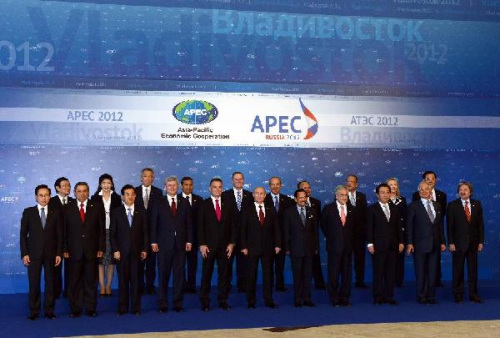
Participants pose for a group photo during the 20th APEC Economic Leaders' Meeting in Vladivostok, east Russia, Sept. 9, 2012. (Xinhua/Rao Aimin)
Economic leaders of the Asia-Pacific Economic Cooperation (APEC) members wrapped up their two-day annual meeting on Sunday with a pledge to promote integration and innovative growth.
Against the backdrop of a bumpy recovery of the world economy and a slowdown of emerging markets, APEC economies need to turn words on paper without legal binding into concrete steps, to inject new impetus into growth in the Asia-Pacific Rim and the prosperity of the world as a whole, experts say.
TANGIBLE FRUITS
Under the theme of "Integrate to Grow, Innovate to Prosper," APEC leaders agreed that robust international trade, investment and economic integration were key drivers of strong, sustainable and balanced growth.
After a week of intensive negotiations, policymakers of the 21-member bloc worked out clear strategies for the region's future, especially on promoting trade and investment liberalization, fostering economic integration, safeguarding food safety, building reliable supply chains and facilitating innovative growth.
As Chinese President Hu Jintao said at the meeting, though the Asia-Pacific region "maintained sound momentum of growth," member economies should not overlook the impact of the ailing world economy on the region and address common challenges together.
Leaders reaffirmed their commitment to strengthening a multilateral trading system, vowing to push forward the Doha Round of global trade talks.
Amid a rising risk of protectionism and continuing uncertainties in the global economy, the APEC economies pledged to refrain until the end of 2015 from raising new barriers to trade and investment, and to not impose new export restrictions or implement WTO-inconsistent measures in all areas.
With regard to regional integration, the leaders recognized the Free Trade Area of the Asia-Pacific (FTAAP) as a major instrument to further APEC's regional economic integration agenda.
Highlighting the importance of establishing reliable supply chains, the leaders agreed to achieve a 10-percent improvement in supply-chain performance by 2015 in the Asia-Pacific region.
Some industry leaders said the Vladivostok meeting had given positive signals to business circles in the region.
Oleg Deripaska, CEO of leading Russian aluminum company United Company Rusal, said APEC had evolved into a forum for pragmatic cooperation in which relevant players "could reach consensus via negotiations and make agreements into actions".
EFFICIENT MECHANISM
Though derogated as "a gathering of waffling" by some, the APEC forum, with a number of clear-cut action plans, empowered its members to put goals and visions into realities, analysts said.
One major achievement of this year's forum was the adopting of a list of eco-friendly goods for tariff reduction, which was lauded by Russian President Vladimir Putin as an example of the mechanism's flexibility and efficiency.
After several months' hard work by APEC foreign and commerce ministers, member economies on Sunday approved a list of 54 items of environment-friendly goods, whose tariffs would be cut to 5 percent by 2015.
"The same procedure has taken the World Trade Organization over 10 years without a result, while it took the APEC just several months to come up with the list," Putin told reporters after the leaders' meeting.
The Russian president admitted it was not easy to come up with the list, without giving details of the goods.
By reaching consensus on the development of green growth, leaders demonstrated their commitment to seek practical, trade-enhancing solutions to global challenges, experts said.
Chinese Commerce Minister Chen Deming praised the hard-to-get approval, saying it showed a "good intention" of cooperation among member economies.
Since its inception in 1989, APEC has helped to reduce barriers and promote integration in the region. Its 21 member economies are home to more than 2.7 billion people and represent about 53 percent of the world's real GDP and 44 percent of its trade.
As was stressed in the group's principles, to maintain long-term growth and prosperity, APEC members need to strengthen integration on the basis of voluntarism, reach consensus via negotiations, and seek common ground while reserving differences.

Copyright ©1999-2011 Chinanews.com. All rights reserved.
Reproduction in whole or in part without permission is prohibited.